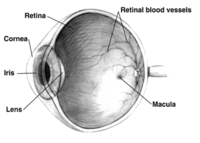
Photo from wikipedia
Introduction. Diabetes mellitus contributes to the development of microvascular complications in the eye. Moreover, it affects multiple end organs, including brain damage, leading to premature death. The use of adaptive… Click to show full abstract
Introduction. Diabetes mellitus contributes to the development of microvascular complications in the eye. Moreover, it affects multiple end organs, including brain damage, leading to premature death. The use of adaptive optics technique allows to perform non-invasive in vivo assessment of retinal vessels and to identify changes in arterioles about 100 μm in diameter. The retinal vasculature may be a model of the cerebral vessels both morphologically and functionally. Aim. To evaluate morphological parameters of retinal arterioles in patients with type 1 diabetes mellitus (DM1). Material and methods. The study included 22 DM1 patients (13 females) aged 43.00 ± 9.45 years with a mean diabetes duration of 22.55 ± 10.05 years, and 23 healthy volunteers (10 females) aged 41.09 ± 10.99 years. Blood pressure, BMI, waist circumference, and metabolic control markers of diabetes were measured in both groups. Vascular examinations were performed using an rtx1 adaptive optics retinal camera (Imagine Eyes, Orsay, France); the vessel wall thickness (WT), lumen diameter (LD), wall-to-lumen ratio (WLR), and vascular wall cross-sectional area (WCSA) were assessed. Statistical analysis was performed with the application of IMB SPSS version 23 software. Results. The DM1 group did not differ significantly in age, BMI, waist circumference, blood pressure, or axial length of the eye compared to the control group. Intraocular pressure (IOP) in both groups was normal, but in the DM1 group it was significantly higher. The DM1 group had significantly higher WT, WLR, and WCSA. These parameters correlated significantly with the duration of diabetes, but not with IOP. Conclusions. The presented study demonstrates the presence of significant morphological changes in retinal vessels in DM1 patients without previously diagnosed diabetic retinopathy. Similar changes may occur in the brain and may be early indicators of cardiovascular risk, but further investigation is required to confirm that.
Journal Title: Biomedicines
Year Published: 2022
Link to full text (if available)
Share on Social Media: Sign Up to like & get
recommendations!